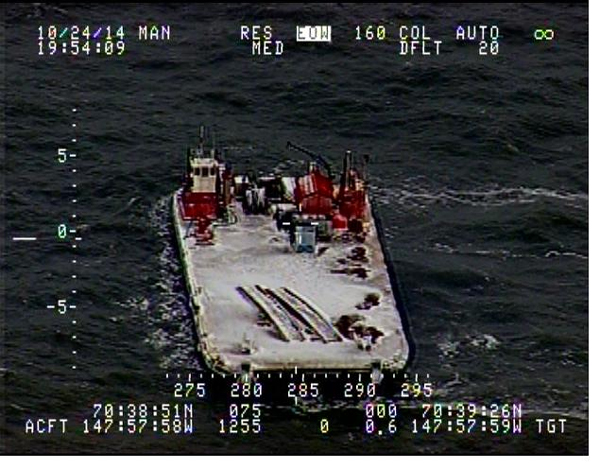Last week a 134' barge broke away from its tow in the Arctic's Beaufort Sea during a storm. The barge was returning to Tuktoyaktuk, located on the Arctic coast at the uppermost edge of Canada, after delivering supplies to a remote site. It was free of cargo but was carrying approximately 950 gals. of light diesel in fuel tanks, according to the CBC.
For the safety of the crew during the storm, the tug continued on without the unmanned barge, which drifted west into U.S. waters. As of Monday, the barge was drifting toward Arctic sea ice north of Prudhoe Bay, according to Coast Guard commander Shawn Decker.
The barge's owner, Canadian marine operator and barging company Northern Transportation Corp., hasn't been able to locate any nearby tugs to rescue the barge so it is likely to remain in the area until it becomes locked-in by sea ice. The barge will probably remain stuck there until next summer, Decker said.
Northern Transportation has assured the Coast Guard that the vessel won't be compromised if it spends winter locked in the ice, the CBC reported.
According to a Beaufort Regional Environmental Assessment from 2012, overwintering of vessels and barges has been carried out in the Arctic for many years, in the Beaufort as well as in other regions of the Arctic and southern Canada. However, the report explains that it is not clear what conditions are required to ensure safe overwintering.
The report concludes: "It is not sufficient to say that a vessel will be in landfast ice conditions throughout the winter. There are many locations where a vessel may be in landfast ice conditions for most of the winter, but the vessel may be in dynamic conditions come the spring break-up period. During this period, depending upon the location, ice crushing forces on a vessel and/or ice loads can be sufficient to break mooring lines and potentially damage a vessel."
If the barge can not be retrieved before becoming engulfed in Arctic sea ice, a Coast Guard plane will drop a GPS tracker on board to make sure it doesn't break loose from the location of its freeze-in and begin leaking fuel.
What do you think of plans to leave the barge until next spring?




